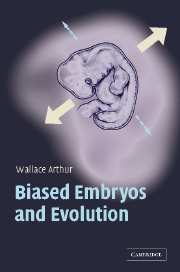Book contents
- Frontmatter
- Contents
- Preface
- Acknowledgements
- 1 The microscopic horse
- 2 What steers evolution?
- 3 Darwin: pluralism with a single core
- 4 How to build a body
- 5 A brief history of the last billion years
- 6 Preamble to the quiet revolution
- 7 The return of the organism
- 8 Possible creatures
- 9 The beginnings of bias
- 10 A deceptively simple question
- 11 Development's twin arrows
- 12 Action and reaction
- 13 Evolvability: organisms in bits
- 14 Back to the trees
- 15 Stripes and spots
- 16 Towards ‘the inclusive synthesis’
- 17 Social creatures
- Glossary
- References
- Index
2 - What steers evolution?
Published online by Cambridge University Press: 02 December 2009
- Frontmatter
- Contents
- Preface
- Acknowledgements
- 1 The microscopic horse
- 2 What steers evolution?
- 3 Darwin: pluralism with a single core
- 4 How to build a body
- 5 A brief history of the last billion years
- 6 Preamble to the quiet revolution
- 7 The return of the organism
- 8 Possible creatures
- 9 The beginnings of bias
- 10 A deceptively simple question
- 11 Development's twin arrows
- 12 Action and reaction
- 13 Evolvability: organisms in bits
- 14 Back to the trees
- 15 Stripes and spots
- 16 Towards ‘the inclusive synthesis’
- 17 Social creatures
- Glossary
- References
- Index
Summary
In science, as elsewhere, it is pointless to fight the same battle twice. The only way to avoid such wasteful activity is to know about the battles that have gone before. So, while I am no historian, and you may not be either, we all need to know enough about the history of evolutionary biology, and the battles that have been fought between the 1800s and today, in order to fight a new battle that will advance knowledge. If we fail in this task, we are merely cluttering up the literature (in my case) and our brains' limited storage capacity (both of us) with unnecessary duplication of battles that have already been fought.
Of course, I cannot do justice to the history of evolutionary biology in a single chapter. But that's no problem, really, for two reasons. First, there are lots of books ‘out there’ for anyone who is interested; and second, I only need to deal here with those past battles that are most relevant to the one that I have chosen to fight in the present. This concerns the forces that ‘steer’ or ‘drive’ evolution in particular directions rather than others. So the focus of my history will be just such driving forces, and how thinking about them has altered from Darwin's day to our own.
It hardly needs to be said that ‘driving forces’ are at the very heart of things. Evolution has been going on for three or four billion years, and has produced all the particular creatures that we see around us, including our fellow humans.
Information
- Type
- Chapter
- Information
- Biased Embryos and Evolution , pp. 8 - 24Publisher: Cambridge University PressPrint publication year: 2004
